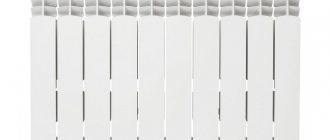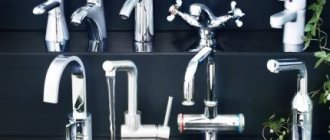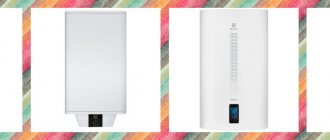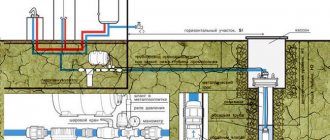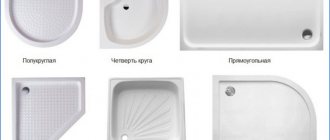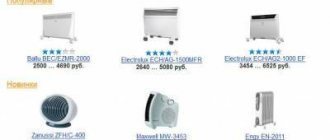The problems of low quality and unstable composition of water that flows from the tap are relevant for many cities in Russia. According to experts in the field of water supply, the main reasons for this phenomenon lie in the lack of control of sanitary zones around water intakes, insufficient equipment of distribution nodes and deterioration of water supply networks. An effective way to solve this problem at home or in your own apartment is to install a membrane filter that operates on the principle of reverse osmosis (RO). Below we will look at the basic elements of technology, equipment for domestic and industrial water treatment systems.
Reverse osmosis: what is it?
Reverse osmosis is a method of water purification in which a solution passes under pressure through a special synthetic membrane, where up to 98% of mineral salts and impurities are retained. People first started talking about the reverse osmosis process back in the 50s of the 20th century. Today, reverse osmosis is considered the most effective method in the field of water treatment. It is in demand both among industrial enterprises and in private homes. Reverse osmosis permeate is purified water that is supplied for technical and drinking needs.
What is osmosis and reverse osmosis: what are the differences
The phenomenon of osmosis (forward osmosis) underlies the metabolic processes of all living organisms at the cellular level. Thanks to it, water-salt metabolism, obtaining nutrients, and removing waste products “work.” For the process to take place, a solution, a solvent and a semi-permeable membrane separating them, which is a barrier to the dissolved substance, are needed.
Forward osmosis is a baromembrane mass transfer process. It can be described as follows: osmotic pressure arises from the solvent side, which forces its molecules to move to the solution side and dilute it. An increase in the volume of the solution is accompanied by an increase in hydrostatic pressure. The process stops when the static and osmotic pressures reach equilibrium.
Important! In plant and animal organisms, the role of a semi-permeable partition is played by the cell wall. Artificial membranes are made from organic synthetics.
If you apply pressure from the solution, the process will go in the other direction. This is reverse osmosis. In the process of reverse osmosis, the concentration of the solution increases on one side of the membrane, and the volume of the solvent increases on the other.
What is a reverse osmosis membrane
Reverse osmosis filters use semi-permeable membranes. The reverse osmosis membrane consists of:
- selective layer, which is a barrier to impurities;
- reinforcing layer that sets the strength parameters of the membrane.
In a reverse osmosis filter cartridge, the membrane is rolled into a roll. This design allows you to obtain a large active surface area and place it in a compact housing of a standard size.
The reverse osmosis membrane is the main element in the purification system. The following materials are suitable for the manufacture of membranes:
- Cellulose acetate. Inexpensive and easy-to-manufacture membranes made from this material appeared in the 1950s. They do an excellent job of purifying water from salts with a large molecular weight, but “miss” a number of low molecular weight compounds. In addition, they operate within a limited pH range and are biodegradable. Currently, cellulose acetate has been replaced by more advanced materials.
- Reinforced polyamide. The material works in a wide pH range and is not a breeding ground for microorganisms. Durable polyamide membranes withstand high operating pressures and have good selectivity to NaCl and organics. The main disadvantage is low resistance to oxidizing agents. Water with a high chlorine content quickly damages polyamide membranes.
- Thin film composites. Membranes made from this material are the most advanced to date. Composite films have high selectivity to all known impurities.
Myths
Among users of filtering systems there are always skeptics who claim that water after cleaning becomes tasteless, unhealthy, and even wastewater pollutes the environment. Let's try to dispel such guesses.
Reverse osmosis flushes out the minerals our bodies need.
The liquid that comes into our tap contains many useful mineral inclusions, however, the percentage of them is so small that it cannot have any effect on our health. But the content of heavy particles indigestible by the body is quite impressive. For those who want to receive more micro and macroelements, it is better to consider a balanced diet.
A large number of drains
To wash the membrane, some of the water is actually used, which makes it possible to replace the expensive component several times a year and keep the system clean. Sewage is discharged into the sewer system, but is quite purified and can be used for irrigation and other domestic needs.
Nobody needs pre-filters
The main filter element is sensitive to high contents of chlorine, iron and organics, so mechanical cleaning leads to a reduction in the volume of these products to acceptable levels, ensuring the correct operation and durability of the purifier.
This H2O is absolutely tasteless, lifeless
There is no clear confirmation of this statement. When a person drinks liquid from the tap for several years, he gets used to its taste. In comparison with chlorinated tap water or sweetish iron-containing water, it really can be considered “empty”. It also does not have the metallic aftertaste associated with well water. However, many note the similarity with thawed milk, which is the standard of quality. This effect is achieved by using a carbon filter.
Filtered composition spoils teeth
The membrane, along with various impurities, also separates fluoride, which is necessary to strengthen tooth enamel. Will the lack of calcium gradually lead to tooth decay? In theory yes, but in practice no. For more than 30 years, scientists have been conducting research in this area and not a single patient has yet developed problems with the oral cavity while consuming distilled H2O.
Too expensive a purchase
If we talk about the initial installation of the system, the cost will be around 20,000 rubles. Further, it is necessary to change the filter elements twice a year, post-filters and the membrane unit - once a season. The price for consumables will be about 5,000 rubles. It turns out to be a decent amount, which makes you think about the need to purchase. However, calculate the amount of consumption per year (minimum 2 liters per day and 700 liters) and it turns out that a liter costs about 50-60 kopecks. It is unlikely that you will find a bottled version in the store for that kind of money. Plus, you will be confident in the quality of the product purified by our own system.
Main table dispenser AquaPro 919H/RO (hot and cold water)
Main table dispenser AquaPro 929CH/RO (cooling/heating)
Floor dispenser AquaPro 311 (empty, without cooling)
Why do you need filters with a reverse osmosis system?
Reverse osmosis systems are units that do a good job of removing dissolved mineral salts. Water purification by reverse osmosis is the removal of inorganic compounds from water from 90 to 98%.
Membranes are good at filtering out organic substances, the molecules of which are much larger than those of mineral salts. Compounds with a molecular weight above 150 Da are removed from water by 100%. The likelihood of bacteria and viruses penetrating through the filter is almost zero. The exception is cartridges with mechanical damage to the membrane. Purified water obtained from a normally operating installation does not require boiling or dosing of disinfectants.
But what does reverse osmosis purify? Are all substances retained on membranes? Reverse osmosis membranes freely pass dissolved diatomic gases: oxygen, nitrogen, hydrogen.
Water with a total mineralization of 3 - 20 g/l with a turbidity of up to 5 EMF and permanganate oxidability of up to 3 mgO2/l can be subjected to purification using OO. Among the requirements of most membrane manufacturers for source water, one can also highlight the absence of strong oxidizing agents (free chlorine, ozone) and divalent iron.
What is the essence of reverse osmosis?
Reverse osmosis of water is a process that produces clean drinking and industrial water. Reverse osmosis units are used at the following facilities:
- Hydroelectric power plants, thermal power plants, nuclear power plants and other energy enterprises;
- Housing and communal services, for water supply of first category facilities;
- scientific and research laboratories, including the defense complex;
- individual water supply.
What should the air pressure be?
Standard air pressure parameters are 0.3-0.5 bar. Most manufacturers adhere to the maximum specification. You can't do more. This may cause the check valve, which is installed between the filters and the storage tank, to automatically close. Water passing through the filter will not open it, because its pressure will not be enough to withstand the pressure from the tank.
If the pressure is high, it can lead to rupture of the rubber partition; if insufficient, the reverse osmosis technology will be disrupted, that is, the water will not be filtered. Therefore, it is very important to control the pressure inside the storage tank.
Check the pressure through the installed nipple. A pressure gauge can be connected to it. Experts recommend using an electronic type pressure gauge for checking. It's more accurate. Some people use car pumps; they already have a dial-type pressure gauge installed in their design. It has a large error, so this device cannot guarantee high measurement accuracy.
If over time the pressure inside the storage tank has dropped, air can be pumped in with the same car pump. If a compressor is available, it is better to use it. The main thing is to carry out control and not allow the parameter to be exceeded.
Why do you need a reverse osmosis installation?
The main areas of use of reverse osmosis plants are water purification in order to reduce overall mineralization and desalination of brackish waters. A reverse osmosis filter is one of the pre-treatment stages in obtaining ultra-purified water for the electronics industry, medicine, and thermal power engineering.
Another direction of using reverse osmosis is the production of concentrates, which is widely used in the food industry. Condensed milk and concentrated juices are produced by reverse osmosis.
Purification stages
The reverse osmosis operating diagram is as follows:
- First, the water undergoes preliminary purification in tanks.
- From there it goes to a semi-permeable barrier, where it is divided into two directions: one passes through the cells, and the other washes them from the outside and drains into the drain with all the debris particles.
- Next, the liquid goes through a post-purification stage in a special container, where all foreign odors are removed and mineralization is carried out.
According to this technology, maximum contaminants are removed from the natural resource, ensuring purity of 99.9 percent.
Industrial reverse osmosis: what is it?
Commercial and industrial reverse osmosis units are high-performance water purification systems with semi-automatic or fully automated controls. They include several modules responsible for preliminary preparation and membrane cleaning.
A typical industrial reverse osmosis installation for producing process water consists of the following elements:
- Coarse filter. A mesh with a certain mesh size traps insoluble particles.
- Iron removal column. In it, divalent iron is oxidized to trivalent and removed in the form of an insoluble precipitate.
- Sorption filter. The active sorbent absorbs free chlorine.
- Reverse osmosis membrane. Removes dissolved salts and other contaminants. One of the advantages of industrial reverse osmosis plants is scalability. To increase productivity, you can add the required number of filter elements.
Reverse osmosis: how it works
For reverse osmosis to occur, high operating pressure is required, which is created by a high-pressure pump. The systems are equipped with sensors, pressure gauges, automatic relief valves, and piping. To control the quality of purified water, a TDS meter is installed.
The installation operation consists of two stages:
- Water purification.
- Washing the membrane.
Control is performed by a microcontroller. Since the source water differs in composition, the configuration and adjustment of the system is carried out individually. Additional pre-preparation steps may be required.
Important! If the quality of the source water is good, it is possible to eliminate some stages of pre-filtration, simplifying and reducing the cost of installation.
Household reverse osmosis for water: what is it for?
The equipment market offers a wide selection of modular reverse osmosis systems for private houses and cottages, which are usually placed in a separate room. There are also monoblock models for apartments with centralized water supply. They are distinguished from industrial reverse osmosis systems by two parameters: productivity and water consumption. But what is reverse osmosis in household filters?
A household reverse osmosis system is a compact device that operates at relatively low pressures (up to 3 atmospheres). Most often, they do not have a booster pump, and filtration occurs due to the pressure in the water supply. Such installations produce several liters of purified water per day, which is quite enough for a private consumer. Due to the low operating pressure, a household membrane requires washing more often than an industrial one.
In household installations, after reverse osmosis, a mineralizer is installed - a post-processing device that enriches the water with minerals beneficial to humans in the required concentrations. This water is intended exclusively for drinking. Mineralization does not affect the preparation of food or hot drinks at all (or has a negative effect).
Important! The service life of household and industrial reverse osmosis membranes from most manufacturers is 1 year. Pre-cleaning cartridges are changed every six months.
How to choose the optimal model
The standard purchase kit includes: three pre-cleaning cartridges - one for post-cleaning - and a membrane. The composition of filter elements, depending on the model and manufacturer, may vary, including various modules with carbon, silver ions, disinfectant, etc., which improve the taste of water.
- The dimensions of the system components, as a rule, comply with uniform standards, so they can be easily replaced if necessary. Having studied the market, you can understand that Russian-made samples are several times cheaper than foreign ones, however, in terms of quality they are practically no different from them.
- It is better to buy expensive equipment from manufacturers or official dealers, where you will be provided not only with guarantees and certificates of conformity, but will also be given a technical passport, as well as detailed operating instructions.
- The size and power are selected based on the people living in the house and the free space allocated for the tank. The most purchased tank volume for the average family is 8-12 liters.
- When choosing, pay attention to the pressure in your water supply system. The normal value is 2.8 bar. If the value is lower, it makes sense to purchase a unit with a pump, otherwise the pressure in the tap will not be sufficient for comfortable use. If the figures are too high, you will have to purchase a reduction gear.
- Don't buy a membrane that is too efficient. 7 liters per hour is a sufficient volume for a family of 4-5 people.
SF-mix manual up to 0.8 m3/h
AMETHYST - 02 M up to 2 cubic meters/day.
Aeration unit AS-1054 VO-90
Since 1991, it has been a developer of water treatment equipment for domestic and industrial needs. We offer a full package of work on its assembly, installation and commissioning. To become the owner of reliable reverse osmosis stations using foreign components, contact our consultants. Customers can expect: prompt processing of applications, assistance in choosing, delivery, promotions and discounts.
Why are reverse osmosis filters in demand?
Reverse osmosis systems have many advantages:
- High water quality with low energy consumption.
- Unlimited productivity and relatively small dimensions.
- Low operating costs.
- The concentrate does not require disposal and is discharged into the sewer.
Diasel company sells industrial and domestic reverse osmosis systems. Our specialists will offer a ready-made modification or select a set of equipment for private customers and enterprises. We will find a solution based on the results of the analysis of the source water and the required productivity. You can submit an application through “Feedback” or by calling 8-499-391-39-59.



